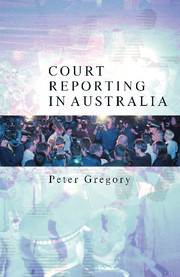Book contents
- Frontmatter
- Contents
- Figures and Tables
- Acknowledgments
- Introduction
- Chapter 1 The Court System: An Overview
- Chapter 2 Gaining Information
- Chapter 3 Contempt
- Chapter 4 Defamation
- Chapter 5 Writing the (Newspaper) Story
- Chapter 6 Subediting and Photography
- Chapter 7 Television and Radio
- Chapter 8 Human Relations and Ethics
- Chapter 9 An Atypical Friday at Court
- Chapter 10 Suppression Orders
- Chapter 11 Future Directions and Issues
- Bibliography
- Index
Chapter 6 - Subediting and Photography
Published online by Cambridge University Press: 22 September 2009
- Frontmatter
- Contents
- Figures and Tables
- Acknowledgments
- Introduction
- Chapter 1 The Court System: An Overview
- Chapter 2 Gaining Information
- Chapter 3 Contempt
- Chapter 4 Defamation
- Chapter 5 Writing the (Newspaper) Story
- Chapter 6 Subediting and Photography
- Chapter 7 Television and Radio
- Chapter 8 Human Relations and Ethics
- Chapter 9 An Atypical Friday at Court
- Chapter 10 Suppression Orders
- Chapter 11 Future Directions and Issues
- Bibliography
- Index
Summary
Subediting
Subediting a court story sounds easy. You have a space to fill on a newspaper page and a story to fit into it. You take out the bits that don't fit in the space, keep the essential elements like charges and names of the main players, compose a headline, check that all the spellings are correct, and move on to the next job. If only it were that simple.
Clashing egos, poor communication, false assumptions and risky guesses are some of the faults that can destroy the accuracy of the finished product. Reporters can be precious about changes to their copy, subeditors flippant or ignorant about the structure of the story. Arguments can occur about the paragraphs to be cut so that a story can fit the available space. Reporters like a remark quoted by Supreme Court judge Justice Bernard Teague (1998–99) in a legal magazine, and said to have come from a former Age editor: ‘The strongest human drive is not that which pursues sex or food, but the uncontrollable urge to change another person's copy.’
Court reporters are not blameless, either. One newspaper veteran, who had a short subediting stint as he moved from courts to other areas, showed amazement as he described those of his colleagues who could not spell, write or compose an intelligible sentence.
Another subeditor told at one paper how some reporters were called ‘The Untouchables’.
- Type
- Chapter
- Information
- Court Reporting in Australia , pp. 91 - 107Publisher: Cambridge University PressPrint publication year: 2005



